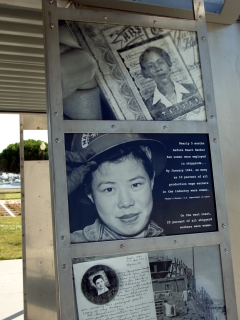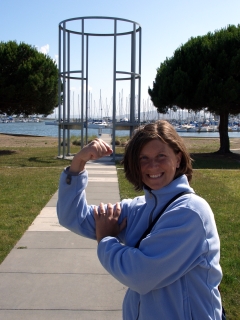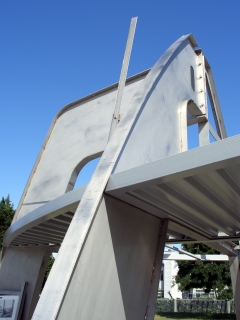NPS Website; Local Website; RosietheRiveter.org
 WHAT IS IT?
WHAT IS IT?Site dedicated to preserving the memory of the 100,000+ women who took jobs in the Richmond shipyards during World War II.
BEAUTY (4/10)
At first glance, signs to the Rosie the Riveter Memorial direct one to a non-descript grassy acre criss-crossed by cement sidewalks and buttressed on either end by abstract metal structures reminiscent of playground jungle gyms. Walk to an end of the center sidewalk and look down its length. You can just make out the forms of a ship.
The cylindrical tower closest to the water is the skeleton of a Liberty ship’s smoke stack; the angled pyramid at the other end its hull. Shrubs and native plants assist in outlining the vessel. Incorporated in the metal and steel are black and white photos of women at work, presumably constructing the pieces of ship you are walking through. The sidewalk, the spine of the Memorial, is actually a timeline of women’s involvement in and the evolution of workers’ rights during WWII.
HISTORICAL INTEREST (7/10)
Our historical interest rating reflects not only the Site’s relative importance but also how the Park effectively portrays its role in the Past. The role of the hundreds of thousands of Rosie the Riveters were as much of a factor in the Third Reich’s defeat as the brave American GI’s of the greatest generation.
The abstract Memorial sparks interest in the woman’s role in the World War II Homefront but the Site needs more (and is getting more) exhibits, explanations and Rangers.
CROWDS (4/10)
The Memorial is located within a small city park adjacent to the Richmond marina. We saw a few dog walkers and a professional photographer snapping shots of the Memorial. Still, the area surrounding the Park felt awful barren and scarily industrial despite the anomalous green presence around the Memorial.
 EASE OF USE/ACCESS (3/5)
EASE OF USE/ACCESS (3/5)Right now, not much of the future NHP is accessible. You can see the warehouse buildings from the outside but you can’t go in. In fact, the auto tour booklet warns, “Do not stop your car along the route once you enter the shipyard…You may NOT walk into the closed areas of the Port…you could be arrested if found on foot.” The auto tour doesn’t exactly beckon, does it?
The Rosie the Riveter Memorial is much more accessible. Take the Marina Bay Parkway Exit of Interstate 580. Go south for about a quarter mile on Marina Bay Parkway. Turn right on Regatta Boulevard and then a quick left onto Melville. The large Marina parking lot awaits; the Memorial is right there.
Exit the same way. We tried to exit via Marina Way South and wound up on dead end streets in a warehouse district. If you turn left from the Memorial onto Regatta you reach a T intersection with Marina Way South. The moral is: if you want to take the driving tour and explore the Richmond shipyards, get a more specific map at City Hall, located at 1401 Marina Way South.
CONCESSIONS/BOOKSTORE (1/5)
There is no bookstore.
COSTS (4/5)
Viewing the Memorial is free.
RANGER/GUIDE TO TOURIST RATIO (1/5)
No Rangers. The Park’s “Visitor Center” is the Richmond City Hall. The building is not nearly as grand as the name may suggest. The City Hall occupies the first floor of an anonymous 1990’s-era cookie-cutter office complex. The busy receptionist can give you a park map and the National Parks Passport stamp while she juggles phone calls.
TOURS/CLASSES (2/10)
Not much, but there is hope. On May 29, 2005, the National Park Service approved a $4.5 million funding package” for a future Visitor Center and presumably a Museum to be located at the former Ford Assembly Plant.
The Memorial’s mix of metal and concrete is enhanced by quotes by and historical facts about Richmond’s many Rosie the Riveters. The Memorial’s brief educational tidbits were the Site’s primary educational tool. A makeshift exhibit panel has been set up in the Richmond City Hall, which serves as the Park’s Visitor Center (sans Ranger).
 FUN (3/10)
FUN (3/10)We skeptically approached the Memorial thinking we would take a few snapshots then be on our way. The photos, postcards and words of women instrumental in our country’s success during and after the war drew us in for a closer look. We read every quote. We wanted to know more. The Memorial is effective.
As of this writing, there is little more to do after a stroll along the Memorial and a brief auto tour. We probably spent more time trying to exit the Marina area and get back on the Interstate than we did exploring the Site. We are optimistic that the Site will harness the curiosity born from the Memorial and create an attraction deserving of the achievements and contributions of the oft-forgotten female half of the greatest generation.
WOULD WE RECOMMEND? (2/10)
President Bill Clinton dedicated four NPS Sites that revolve around WWII, the first four of their kind in the continental U.S. Two were Japanese Internment Camps. One, Manzanar NHS located in California’s Owens Valley, is finished and is one incredible museum. The Minidoka Internment NM in Idaho is far from finished.
The two remaining Sites are both in the Bay Area, Rosie the Riveter NHP and Port Chicago Naval Magazine NMEM located just a few miles from Richmond in Concord. The two Sites are both in development. The comparisons stop there. Port Chicago is a story of tragedy while Rosie the Riveter is an American story of strength and victory.
Touring the Port Chicago site is much more compelling, primarily because of the Ranger-led tour but also because Port Chicago has not changed. The ghost pier remains and the surrounding land is still a military ammunitions base. The Richmond shipyard environs have changed. The Rosie the Riveter Memorial looks out onto a sailboat-filled marina, stands on a nicely manicured lawn and is surrounded by gated condominium communities.
You can take a driving or walking tour of the shipyards’ warehouses but you cannot go in. From the outside it is difficult to differentiate them from their more recently built industrial neighbors. Without an educational explanation or historical context the buildings elicit very little meaning.
Currently, the Rosie the Riveter NHP does not merit a visit. We have hope that that conclusion will be much different five years from now.
TOTAL 31/80
www.usa-c2c.com
© 2004-06